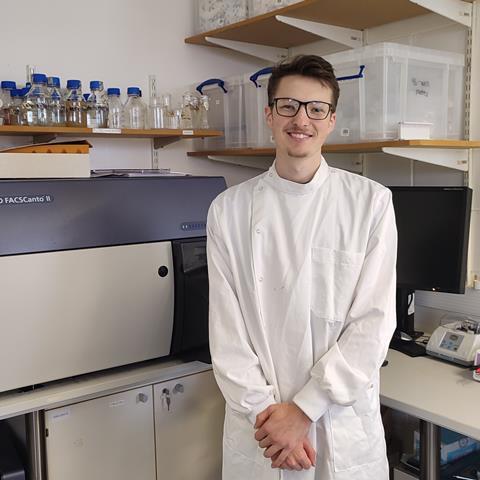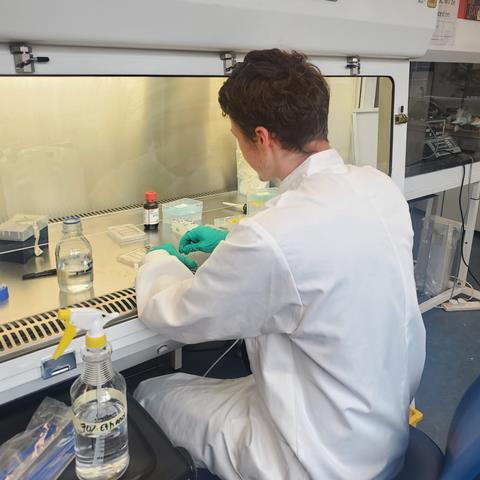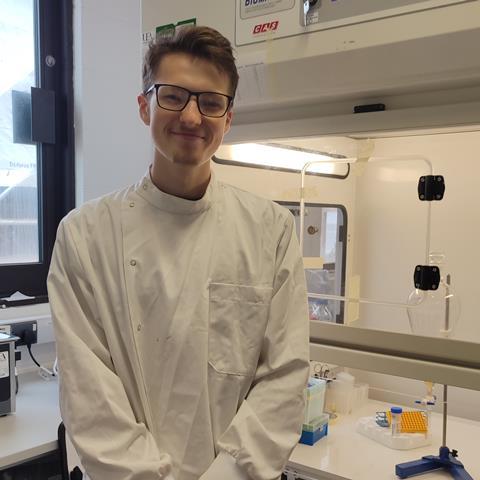Owen Nicholson reports back on his AMI-sponsored summer studentship which investigated the role of Piezo1 in the immune response during fungal invasion of the human lung at the University of East Anglia.
Owen (20) is studying Microbiology Bsc at UEA and has undertaken an internship at the Bidula Lab at UEA where he completed a project in Fungal Pathology focusing on the role of Piezo1 in the immune response during fungal invasion with Aspergillus fumigatus and Candida albicans.

We decided to focus on this area of study as fungal pathology is an under-researched and under-funded area of study which is incredibly important to human health, with 3.8 million deaths annually being attributed to fungal infections and it being a major cause of death for immunocompromised patients.
This issue is being compounded by the emergence of drug-resistant strains of fungi and the lack of new antifungals being developed. Our aim is to gain a better understanding of how fungal hyphae interact with lung cells and the immune system through the receptor piezo1.
Piezo1 is a calcium permeable ion channel that is activated by mechanical action, and is expressed on a wide range of cell that a fungal pathogen may interact with and invade. It can be activated by mechanical stimuli and has been shown to activate the EGFR / ERK pathway which also has been theorised to have a protective role in the host defence against Invasive Aspergillosis.
Lab opportunities
During my time in the lab I have had the opportunity to practice and develop my research skills by planning and conducting assays and interpreting the data received from them. For example, I had sparse experience within a cell biology lab prior to starting the project - however by the end of the eight weeks I knew exactly what I was doing and had the confidence to get it done on my own.

I assessed the ability of human lung cells (A549) and white blood cells (THP-1) to kill A. fumigatus or C. albicans. Following 24 hours of incubation with these cells, fungi were plated and the colonies were counted to quantify the ability of the cells to kill fungi.
I also conducted ELISAs to identify the presence of the inflammatory cytokine interleukin-8 (IL-8). IL-8 was chosen as it is directly implicated in the immune response to fungal invasions and pieszo1 can control IL-8 secretion.
What we found
We found that both Yoda1 (an activator of piezo1) and GsMTx-4 (an inhibitor of mechanical receptors) increased the amount of A. fumigatus killed by the A549 cells while GsMTx-4 had no effect on the ability of THP-1 cells to kill A. fumigatus.
However, we also found that Yoda1 caused a decrease and GsMTx4 causing a slight decrease in the ability of A549 cells to kill C. albicans, with Yoda1 having no effect on the THP-1 cells but GsMTx4 causing an increase in ability of THP-1 cells to kill C. albicans species.
The ELISA identified the presence of IL-8 in samples that contained Aspergillus spores and Aspergillus spores + Yoda1 but did not find IL-8 in any other sample. This shows that IL-8 is only produced if Piezo1 is active and the sensitisation of Piezo1 causes an increase in the amount of IL-8 produced.
Surprising finding
This had surprised us, as A. fumigatus and C. albicans had completely different responses to Yoda1 and GsMTx-4, where they seemingly shouldn’t.
This project aims to identify a part of the pathway responsible for the immune system’s response to fungal invasion which is a crucial part of understanding how a disease works. If we are able to know the biochemical processes which occur during infection, we may then be able to develop therapies and drugs which have an effect on these pathways to help treat the patient.

After completing this internship, I am feeling confident and excited to undergo my third year at university where I will be using the skills I have gained to complete my third-year project. After university I am aiming to go into research within a pathology lab, as pathology and immunity is my passion and I would love to have my research benefit people.
Least favourite job in the lab? It was definitely colony counting; after counting my third 2000+ colony plate I was definitely ready to go home.
Find out more about AMI’s grants.
Topics
- Applied Microbiology International
- Aspergillus fumigatus
- Be inspired
- Candida albicans
- Community
- Early Career Research
- fungal pathology
- Fungi
- GsMTx-4
- hyphae
- immunocompromised
- Immunology
- Infection Prevention & Control
- Infectious Disease
- inflammatory cytokine interleukin-8
- Lung Microbiome
- One Health
- Owen Nicholson
- Piezo1
- UK & Rest of Europe
- University of East Anglia
- Yoda1







No comments yet